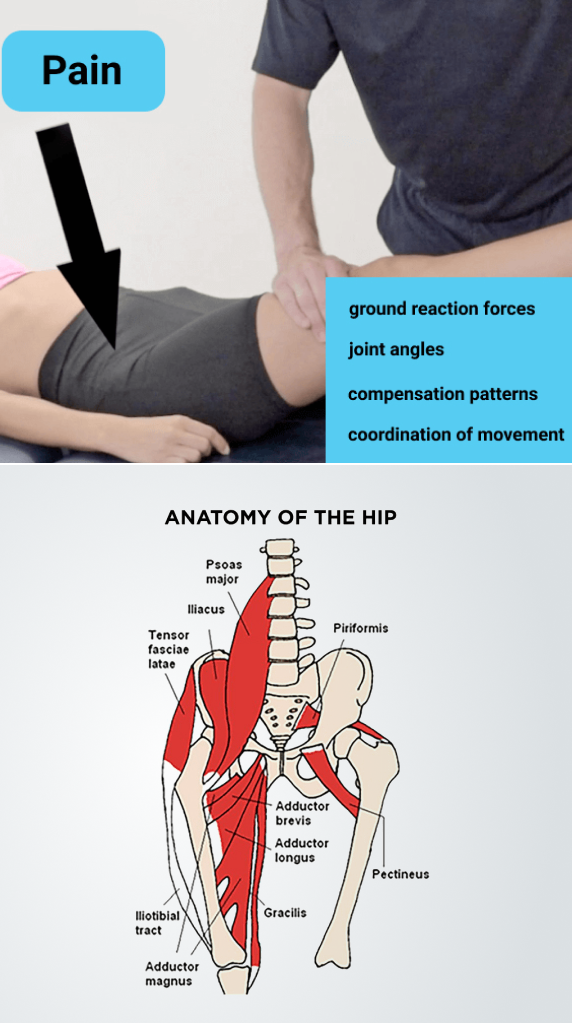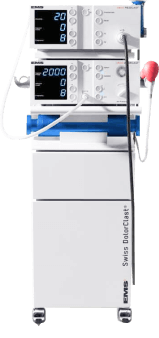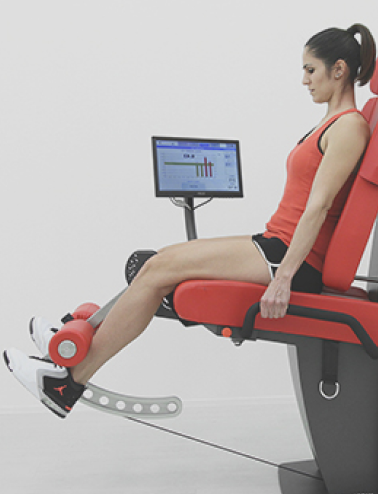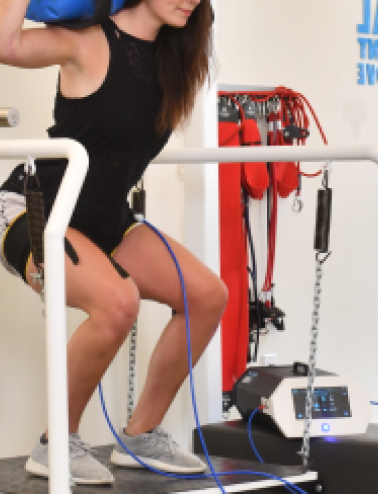Your hip flexors are a group of muscles that act at the hip to lift your leg toward your trunk. During walking and running, the hip flexors play an important role in the swing phase of the gait cycle. For many people, excessive sitting creates shortened and tight hip flexors that restrict hip range of motion, force the body out of alignment, and create gait deficits.
Over time, tight hip flexors can lead to poor balance and increased risk of hip flexor tendinitis. Rehabilitating hip flexor tendinitis entails addressing underlying issues, restoring balanced muscle tension at the hip, and retraining neuromuscular pathways that govern hip movement.
or
NYDNRehab clinical director Dr. Lev Kalika has devoted his life’s work to revolutionizing the way physical pain syndromes and motor disorders are diagnosed and treated. Dr. Kalika is a world-renowned expert in diagnostic musculoskeletal ultrasonography, and has contributed multiple research articles to the growing body of scientific literature on its use in rehabilitative medicine.
The clinic at NYDNRehab features the highest resolution ultrasound equipment available for imaging large structures like tendons, ligaments, nerves, muscles and bones. Our equipment also gives us the capability to test tendon density via sonoelastography, and enables us to detect early signs of tendon fiber healing via superb microvascular imaging (SMI).
Dr. Kalika leverages musculoskeletal ultrasonography, advanced regenerative technologies and cutting edge therapies to treat and rehabilitate hip flexor tendonitis. His 20+ years of hands-on experience and his ongoing commitment to finding the most advanced treatment methods for his patients make NYDNRehab the clinic of choice for musculoskeletal pain treatment in NYC.
In many cases, sensations of tightness at the front of the hip are not directly caused by tight hip flexor muscles. They are sometimes caused by up-regulation of the nervous system due to hip microinstability. In such cases, the feeling of hip flexor tightness cannot be resolved by gently stretching the muscle-tendon unit, and aggressive stretching may cause further damage.
In other cases, hip flexor tendinosis is due to the inability of the foot to push off from a stable base. It can also arise from poor spinal stabilization due to weak and uncoordinated pelvic and trunk musculature, or from other structural issues that shift load to the hip flexors.
If you have sensations of tightness in your hip flexors that are not helped by gentle stretching, you should consult with a qualified therapist who understands the complexity of hip and pelvic architecture, and is aware of the many other factors that contribute to hip flexor tendinitis
Pain and tenderness at the front of the hip
Pain that intensifies when you bend your hip
Hip and/or groin soreness to the touch
Stiffness and reduced hip range of motion
Clicking or snapping sounds or sensations when walking or running
Symptoms that worsen over time
Overuse from sports, running or exercise
Excessive sitting and sedentary lifestyle
Traumatic injury
Overstretching
Suboptimal gait mechanics
Imbalanced hip muscle tension
When based on symptoms alone, hip pain issues can easily be misdiagnosed or under diagnosed. When that happens, it can lead to insufficient or inappropriate treatment that costs you time and money and prolongs your pain. In many cases, inappropriate treatment can worsen your symptoms and increase your risk of further injury.
At NYDNRehab, we believe that what cannot be measured cannot be successfully treated. While your symptoms can help steer us in the right direction, that is only the tip of the iceberg. To get an accurate and comprehensive diagnosis, we leverage advanced technologies that eliminate guesswork and give us objective data.
We use high-resolution diagnostic ultrasonography to get crystal-clear real-time images of the structures of the hip in motion. Ultrasound imaging lets us view all the structures that come into play during hip movement, and enables us to compare the injured and uninjured sides of the body, providing us with insights that cannot be gleaned from Xray or MRI.
In addition, our research-grade ultrasound equipment gives us capabilities for sonoelastography to test the elastic properties of tendons, and superior microvascular imaging (SMI) to detect signs of tissue healing.
Our human movement lab is equipped with advanced technologies for 3D gait and movement analysis, to identify and measure gait anomalies that cannot be detected with the human eye. By collecting data on joint angles, force loads, weight distribution, muscle firing patterns and more, we are able to establish a baseline for treatment. We re-measure periodically throughout the rehabilitation process, to ensure that your treatment protocol is working.


Mainstream clinics often rely on one-size-fits-all physical therapy protocols that do not take into account the unique characteristics of the individual patient. In doing so, they overlook underlying conditions that ought to be treated before beginning physical therapy.
At NYDNRehab we take a personalized and holistic approach to patient care. We treat the patient and not just their symptoms. When conducting a thorough and quantitative analysis, we look for other issues that need to be resolved before beginning physical therapy exercises.
Issues that should be pre-treated prior to beginning physical therapy include:
Pre-treatment eliminates impediments that cause pain and restrict movement, to optimize the effectiveness of physical therapy.
Traditional treatment for hip flexor pain often involves rest, ice and pain management, often with NSAIDs (non-steroidal anti-inflammatory drugs) and corticosteroids. Because traditional practitioners are often unable to distinguish between tendonitis and tendinosis, conventional treatments often fall short of resolving hip flexor pain and stiffness.
At NYDNRehab, your healing journey begins with an accurate diagnosis that identifies the precise locus and extent of injury. Our patient-centric approach values and encourages your feedback, making you a contributing stakeholder in your recovery. Our personalized one-on-one treatment protocols are customized, based on your unique patient profile.
Prior to beginning physical therapy exercises, we identify and treat underlying issues that limit your ability to move freely. We use our advanced regenerative technologies to heal tissues and optimize movement, to set you up for physical therapy success.
Focused ESWT is used as a regenerative treatment for damaged tendons and muscles. This technology produces high frequency sound waves to stimulate cell neogenesis and accelerate healing.
EMTT is a new technology that transmits high energy magnetic pulses that synchronize with the body’s own magnetic fields, to permanently eliminate inflammation in targeted tissues.

Extracorporeal Pulse Activation Technology (EPAT)
EPAT uses acoustic pressure waves to enhance blood circulation, to relax and release large areas of tight muscle and fascia.
TECAR therapy helps to restore the ionic charge of damaged cells, to enhance the effectiveness of manual release therapy. With INDIBA, what once took months to achieve flexibility in the deep hip flexor muscles and fascia now only takes a few sessions.
At NYDNRehab, our advanced training technologies flip muscle strengthening on its head by introducing advanced approaches that circumvent the pitfalls of traditional strength training.

We use the Kineo intelligent loading system to create customized training and rehabilitation programs for our patients. Kineo uses artificial intelligence to design eccentric loading protocols that promote tendon healing.

Rebuilding muscle strength while joints and connective tissues are still healing is a challenge for athletes who need to return to sport in the shortest time possible. BFRT enables you to increase muscle size and strength at much lower training volumes, to reduce stress on still-healing structures while rapidly restoring muscle performance.

An important part of rehabilitation is restoring coordinated muscle firing patterns. Our high-tech performance lab has you covered with AI and VR assisted technologies that fine-tune your every move, to optimize hip flexor function and eliminate movement errors.
Your hip flexor muscles contribute significantly to hip and pelvic mobility and stability. Employ these strategies to avoid injury and optimize hip flexor function:
Avoid overtraining, and allow for ample recovery between training sessions.
Eat a nutrient-dense diet with plenty of collagen-rich protein to support joint and tendon health.
Get enough sleep.
Avoid extended periods of sitting, and take frequent breaks to move and stretch.
Get regular exercise — daily walking is a great place to start.
Avoid extreme or aggressive stretching of the structures surrounding the hips.
Get a 3D gait and movement analysis, to identify and correct issues that contribute to hip flexor pain.

Tendons are notoriously slow to heal due to limited vascularity and their unique collagenous structure. Once damaged, tendons can gradually degenerate, exacerbating pain and dysfunction, and reducing your overall quality of life.
At NYDNRehab, our experience and expertise, coupled with our advanced regenerative technologies, are game-changers for hip flexor tendon rehabilitation. Accurate diagnosis followed by fast and effective treatment make NYDNRehab your clinic of choice for pain syndromes and movement disorders of all types.
You don’t have to live with musculoskeletal pain. Contact us today, and get back to pain-free movement so you can live your best life.
Dr. Lev Kalika is a world-recognized expert in musculoskeletal medicine. with 20+ years of clinical experience in diagnostic musculoskeletal ultrasonography, rehabilitative sports medicine and conservative orthopedics. In addition to operating his clinical practice in Manhattan, he regularly publishes peer-reviewed research on ultrasound-guided therapies and procedures. He serves as a peer reviewer for Springer Nature.
Dr. Kalika is an esteemed member of multiple professional organizations, including: